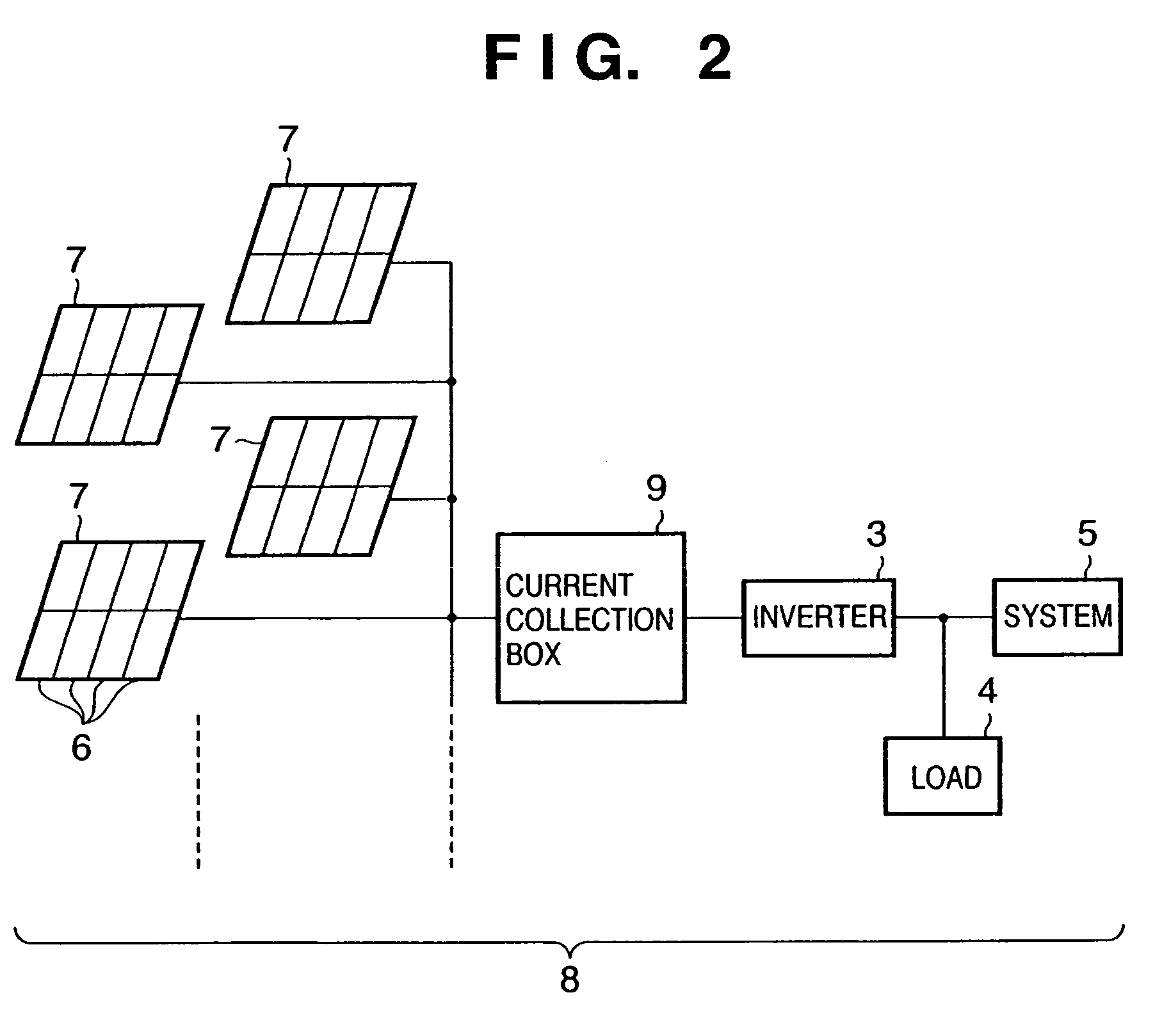Solar power generation apparatus and its manufacturing method
a technology of solar power generation and solar cells, applied in the direction of pv power plants, electrochemical generators, batteries, etc., can solve the problems of increasing the price of solar power generation apparatuses, time and labor for connecting a number of solar cells in series, and reducing the influence of partial shade and characteristic variation, so as to reduce manufacturing costs and reduce the effect of manufacturing cos
- Summary
- Abstract
- Description
- Claims
- Application Information
AI Technical Summary
Benefits of technology
Problems solved by technology
Method used
Image
Examples
first embodiment
[0070]FIG. 1 is a schematic view showing the arrangement of a solar power generation system according to the first embodiment of the present invention. The solar power generation system comprises solar cell assemblies 101 each constructed by a plurality of solar cells formed on one conductive substrate, DC / DC converters 2, an inverter 3, a load 4, and a system 5.
[0071]In this specification, a solar cell is a structure having a photo voltaic layer divided into a predetermined region. A solar cell is a minimum unit having a function as a solar battery capable of extracting a power from its photovoltaic layer.
[0072]The plurality of solar cells in the solar cell assembly 101 are independent from each other. They are not connected in series. A DC power output from each solar cell is input to a corresponding one of the DC / DC converters 2 that are arranged in a one-to-one correspondence with the solar cells. The DC powers are boosted at a predetermined boost ratio. All the outputs from the...
second embodiment
[0187]A solar power generation system according to the second embodiment of the present invention will be described below. A description of the same parts as in the first embodiment will be omitted, and characteristic parts of the second embodiment will mainly be described below.
[0188]FIG. 10 is a schematic view showing the outer appearance of the second embodiment. FIG. 11 is an equivalent circuit diagram of the second embodiment.
[0189]In this embodiment, almost the same solar cell assembly as in the first embodiment is used, and a detailed description thereof will be omitted.
[0190]FIG. 12 is an enlarged view of a connection portion between a DC / DC converter 2 and one of solar cells 22 that constitute the solar cell assembly to which the DC / DC converter used in this embodiment is attached. The attachment position of the DC / DC converter 2 to each solar cell is the same as in the first embodiment except an output terminal 59 extends from the encapsulating portion of the DC / DC convert...
third embodiment
[0203]A solar power generation system according to the third embodiment of the present invention will be described below. A description of the same parts as in the first and second embodiments will be omitted, and characteristic parts of the third embodiment will mainly be described below.
[0204]The solar cell used in this embodiment has almost the same structure as that used in the first embodiment except the multilayered structure of the semiconductor layer.
[0205]More specifically, first, as a lower electrode layer, an Al layer containing 1% Si and having a layer thickness of 5,000 Å is formed by sputtering on a cleaned and rolled long 0.1-mm thick stainless substrate as a conductive substrate. Next, an n / i / p amorphous silicon semiconductor layer is formed. For the p-type semiconductor, B2H6, SiH4, and H2 gases are used. For the i-type semiconductor, SiH4 and H2 gases are used. For the n-type semiconductor, PH3, SiH4, and H2 gases are used. A 100-Å thick p-type semiconductor layer,...
PUM
 Login to View More
Login to View More Abstract
Description
Claims
Application Information
 Login to View More
Login to View More - R&D
- Intellectual Property
- Life Sciences
- Materials
- Tech Scout
- Unparalleled Data Quality
- Higher Quality Content
- 60% Fewer Hallucinations
Browse by: Latest US Patents, China's latest patents, Technical Efficacy Thesaurus, Application Domain, Technology Topic, Popular Technical Reports.
© 2025 PatSnap. All rights reserved.Legal|Privacy policy|Modern Slavery Act Transparency Statement|Sitemap|About US| Contact US: help@patsnap.com



